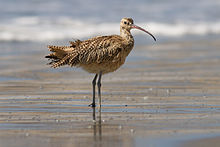Long-billed curlew
| Long-billed curlew | |
|---|---|
 |
|
| Scientific classification | |
| Kingdom: | Animalia |
| Phylum: | Chordata |
| Class: | Aves |
| Order: | Charadriiformes |
| Family: | Scolopacidae |
| Genus: | Numenius |
| Species: | N. americanus |
| Binomial name | |
|
Numenius americanus Bechstein, 1812 |
|
 |
|
| Range of N. americanus | |
| Synonyms | |
|
Numenius longirostra(is) |
|
Numenius longirostra(is)
The long-billed curlew (Numenius americanus) is a large North American shorebird of the family Scolopacidae. This species was also called "sicklebird" and the "candlestick bird". The species is breeds in central and western North America, migrating southward and coastward for the winter.
The long-billed curlew is the largest sandpiper of regular occurrence in North America. It is 50–65 cm (20–26 in) long, 62–90 cm (24–35 in) across the wing and weighs 490–950 g (1.08–2.09 lb). Its disproportionally long bill curves downward and measures 11.3–21.9 cm (4.4–8.6 in), and rivals the bill of the larger-bodied Far Eastern curlew as the longest bill of any shorebird. Individuals have a long neck and a small head. The neck and underparts are a light cinnamon in color, while the crown is streaked with brown. This species exhibits reversed sexual dimorphism, as in many sandpipers, the female being larger and having a much longer bill than the male's.
The breeding habitat is grasslands in west-central North America. The species displays an elaborate courtship dance, with fast and looping display flights also being common. A small hollow is lined with various weeds and grasses to serve as the nest. The species is a determinant layer, a characteristic of shorebirds, laying four eggs, which vary in hue from white to olive. Long-billed curlew young are precocial, the chicks leaving the nest soon after hatching. Though both parents look after the young, females usually abandon the brood to the male 1-3 weeks after hatching and depart for winter grounds. Adults whose nest fails often depart immediately (or nearly so) for winter grounds.
Long-billed curlews often feed in flocks. Using the long bill, an individual probes the mud or other substrate for suitable food. The usual food consists of crabs and various other small invertebrates. The species also feeds on grasshoppers, beetles, and other insects. This bird has been known occasionally to eat the eggs of other birds.
The population was significantly reduced at the end of the 19th century by hunting, though numbers have rebounded somewhat in more-recent times. The species was formerly classified as Near Threatened by the IUCN, but new research has confirmed that the long-billed curlew is again common and widespread. Consequently, it has been downlisted to Least Concern status in 2008.
...
Wikipedia

